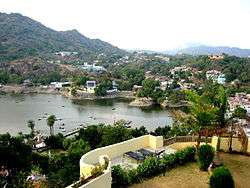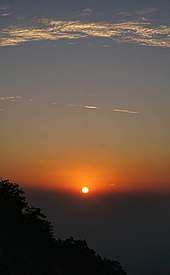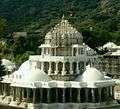Mount Abu
Mount Abu (![]()
Mount Abu Abu Parvat | |
|---|---|
 | |
| Nickname(s): Shimla of Rajasthan | |
 Mount Abu  Mount Abu | |
| Coordinates: 24.5925°N 72.7083°E | |
| Country | India |
| State | Rajasthan |
| District | Sirohi |
| Elevation | 1,220 m (4,000 ft) |
| Population (2011)[1] | |
| • Total | 22,943 |
| • Density | 50/km2 (100/sq mi) |
| Time zone | UTC+5:30 (IST) |
| PIN | 307501 |
| Telephone code | +02974 |
| ISO 3166 code | RJ-IN |
| Vehicle registration | RJ 38 |
| Nearest city | Sirohi, Abu Road, Pindwara, Ahmedabad |
History
The ancient name of Mount Abu is Arbudaanchal. In the Puranas, the region has been referred to as Arbudaranya ("forest of Arbhuda") and 'Abu' is a diminutive of this ancient name. It is believed that sage Vashistha retired to the southern spur at Mount Abu following his differences with sage Vishvamitra. There is another history story according to which a serpent named "Arbuda" saved the life of Nandi (Lord Shiva's bull). The incident happened on the mountain that is currently known as Mount Abu and so the mountain is named "Arbudaranya" after that incident which gradually became Abu.
The conquest of Mount Abu in 1311 CE by Rao Lumba of Deora-Chauhan dynasty brought to an end the reign of the Parmars and marked the decline of Mount Abu. He shifted the capital city to Chandravati in the plains. After the destruction of Chandravati in 1405, Rao Shasmal made Sirohi his headquarters. Later it was leased by the British government from the then Maharaja of Sirohi for use as the headquarters.
Mount Abu and Gurjars
The Arbuda Mountains (Abu Parvat ' Mount Abu) region is said to be original abode of the famous Gurjars. The association of the Gurjars with the mountain is noticed in many inscriptions and epigraphs including Tilakamanjari of Dhanpala.[3] These Gurjars (Gujars or Gujjars) migrated from the Arbuda mountain region. As early as sixth century CE, they set up one or more principalities in Rajasthan and Gujarat. Almost all or a larger part of Rajasthan and Gujarat had been known as Gurjaratra (country ruled or protected by the Gurjars) or Gurjarabhumi (land of the Gurjars) for centuries before the Mughal period.[4]
Mount Abu and Rajputs
According to a legend, sage Vashistha performed a great yajna at the peak of Mount Abu, to seek from the gods a provision for the defense of righteousness on earth. In answer to his prayer, a youth arose from the Agnikunda (fire-altar) — the first Agnivansha Rajput.[5][6] Achalgarh Fort is one of more attracting place which was built by Parmar Rajput kings.[7] Dilwara temple built by mahipala Soalanki (Chalukyu).[8]
Tourism


Mount Abu town, the only hill station in Rajasthan, is at an elevation of 1,220 m (4,003 ft). It has been a popular retreat from the heat of Rajasthan and neighbouring Gujarat for centuries.
The mountain is home to several Hindu temples, including the Adhar Devi Temple (also known as Arbuda Devi Temple), carved out of solid rock; the Shri Raghunathji Temple; and a shrine and temple to Dattatreya built atop the Guru Shikhar peak; and the Achaleshwar Mahadev Temple (1412).
The Achalgarh Fort, built in the 14th century by Kumbha of Mewar, is nearby and at its center is the popular visitor attraction of the Nakki Lake. The Toad Rock is on a hill near the lake. Close to the fort is the Achaleshwar Mahadev Temple, a popular Shiva temple. Also, Achal Fort Jain Temple, Kantinath Jain Temple (1513) is equally famous.
The Durga Ambika Mata Temple lies in a cleft of rock in Jagat, just outside Mount Abu town.
The mountain is also the home to a number of Jain temples including Dilwara Temples, a complex of temples carved out of white marble.The Dilwara Temples or Delvada Temples are located about 2½ kilometres from the Mount Abu settlement, Rajasthan's only hill station. These Jain temples were built by Vimal Shah and designed by Vastupala, Jain ministers of Dholka,[9] between the 11th and 16th centuries and are famous for their use of white marble and intricate marble carvings.[10] They are a pilgrimage place of the Jains, and a popular general tourist attraction.The temples have an opulent entranceway, the simplicity in architecture reflecting Jain values like honesty and frugality.[11] The ornamental detail spreading over the minutely carved ceilings, doorways, pillars, and panels is simply marvellous.[12] The temple complex is in the midst of a range of forested hills. There are five temples in all, each with its own unique identity.[13] All the five temples are enclosed within a single high walled compound. The group is named after the small village of Dilwara or Delvara in which they are located. The five temples are:
- Vimal Vasahi, dedicated to the first Jain Tirthankara, Shri Rishabhadev.
- Luna Vasahi, dedicated to the 22nd Jain Tirthankara, Shri Neminatha.
- Pittalhar, dedicated to the first Jain Tirthankar, Shri Rishabhadev.
- Parshvanath, dedicated to the 23rd Jain Tirthankara, Shri Parshvanatha.
- Mahavir Swami, dedicated to the last Jain Tirthankara, Shri Mahaviraswami.
Among all the five legendary marble temples of Dilwara, the most famous of those are the Vimal Vasahi and the Luna Vasahi temples.[14][15]
In Mount Abu, the faith community of Brahma Kumaris has its spiritual headquarters, which are represented by its own account in 110 countries.[16] Every year about 2.5 million visitors are supposed to visit the sprawling campus of that spiritual movement.[17]
The Mount Abu Wildlife Sanctuary was established in 1960 and covers 290 km² of the mountain.
In Literature
Arbuda Mountains is a mountain range described in the epic Mahabharata. It is identified to be Mount Abu. This mountain is mentioned in the travels of Arjuna during his twelve-year pilgrimage.[18]
Letitia Elizabeth Landon's poem Hindoo Temples on the Mountain-Lake of Aboo, published in Fisher's Drawing Room Scrap Book, 1839, is a reflection on this mountain fastness.
| Wikisource has original text related to this article: |
Climate
Summer
Summer prevails from mid-April to mid-June, when the average maximum temperature remains around 34 °C. It is suited for light cotton clothes.And humidity is comparatively less.
Monsoon
Due to its relief and geographical conditions, it rains in Mount Abu during the monsoons. During the rainy season, the temperature falls. Normal summer clothing works. It is wise to carry an umbrella to avoid being caught in the rain.
Winter
Winters are cool in Mount Abu, with mercury hovering around 13 °C to 22 °C. Nights are chilly, and the average night temperature is around 3 to 12 °C. The temperature has dipped to as low as −1 to −3 °C. Heavy winter clothing is preferable. In the daytime, light pullovers are sufficient.
| Climate data for Mount Abu (1981–2010, extremes 1901–2012) | |||||||||||||
|---|---|---|---|---|---|---|---|---|---|---|---|---|---|
| Month | Jan | Feb | Mar | Apr | May | Jun | Jul | Aug | Sep | Oct | Nov | Dec | Year |
| Record high °C (°F) | 29.0 (84.2) |
30.6 (87.1) |
34.6 (94.3) |
38.8 (101.8) |
40.4 (104.7) |
38.4 (101.1) |
35.0 (95.0) |
31.1 (88.0) |
33.0 (91.4) |
33.6 (92.5) |
30.4 (86.7) |
34.2 (93.6) |
40.4 (104.7) |
| Average high °C (°F) | 19.7 (67.5) |
22.3 (72.1) |
26.5 (79.7) |
30.6 (87.1) |
32.3 (90.1) |
30.2 (86.4) |
24.9 (76.8) |
23.5 (74.3) |
25.6 (78.1) |
27.5 (81.5) |
24.2 (75.6) |
21.5 (70.7) |
25.7 (78.3) |
| Average low °C (°F) | 3.1 (37.6) |
5.7 (42.3) |
10.5 (50.9) |
15.3 (59.5) |
18.5 (65.3) |
18.3 (64.9) |
17.3 (63.1) |
16.6 (61.9) |
15.8 (60.4) |
11.9 (53.4) |
7.1 (44.8) |
3.8 (38.8) |
12.0 (53.6) |
| Record low °C (°F) | −5.7 (21.7) |
−5.8 (21.6) |
0.4 (32.7) |
4.4 (39.9) |
10.0 (50.0) |
13.0 (55.4) |
10.0 (50.0) |
10.6 (51.1) |
6.4 (43.5) |
3.4 (38.1) |
−0.4 (31.3) |
−7.4 (18.7) |
−7.4 (18.7) |
| Average rainfall mm (inches) | 3.5 (0.14) |
1.6 (0.06) |
2.0 (0.08) |
3.0 (0.12) |
10.4 (0.41) |
61.9 (2.44) |
592.9 (23.34) |
516.3 (20.33) |
172.4 (6.79) |
17.7 (0.70) |
3.4 (0.13) |
1.0 (0.04) |
1,386.1 (54.57) |
| Average rainy days | 0.3 | 0.1 | 0.3 | 0.3 | 0.8 | 3.7 | 14.6 | 15.7 | 6.1 | 0.7 | 0.3 | 0.1 | 43.2 |
| Average relative humidity (%) (at 17:30 IST) | 47 | 38 | 34 | 32 | 38 | 55 | 84 | 90 | 76 | 53 | 49 | 49 | 53 |
| Source: India Meteorological Department[19][20] | |||||||||||||
Demographics
According to the 2011 Census of India, Mount Abu has a population of 22,943. out of which 54.7% are males and 45.3% are females. It has an average literacy rate of 81.15%, higher than the national average of 74.04%: male literacy is 90.12%, and female literacy is 70.23%. In Mount Abu, 12.34% of the population is under 6 years of age.[21]
89.31% of people are Hindus, 7.69% are Muslims while 1.45% are Christians.[21]
Gallery
 Parshvanatha Temple at Dilwara group of temples
Parshvanatha Temple at Dilwara group of temples Marble sculpture of Dilwara Temples
Marble sculpture of Dilwara Temples Kalpavriksha or Kalpavruksha page in Dilwada Jain Temple
Kalpavriksha or Kalpavruksha page in Dilwada Jain Temple Nakki Lake after sunset
Nakki Lake after sunset Brahma Kumari foundation headquarters at Mount Abu
Brahma Kumari foundation headquarters at Mount Abu- Mount Abu Wildlife Sanctuary covers 290 km² of mountains, forests and lake.
 Turtle shaped rock near Nakki Lake.
Turtle shaped rock near Nakki Lake..jpg) Toad rock on a hill near the Nakki Lake.
Toad rock on a hill near the Nakki Lake.
References
- "Census of India Search details". censusindia.gov.in. Retrieved 10 May 2015.
- Agarwal, Deepesh. "How to reach Mount Abu by Road, Air Or Rail". www.mountabu.com. Retrieved 22 June 2017.
- Sudarśana Śarmā (2002). Tilakamañjarī of Dhanapāla: a critical and cultural study. Parimal Publications. p. 214.
- Ramesh Chandra Majumdar; Achut Dattatrya Pusalker; A. K. Majumdar; Dilip Kumar Ghose; Vishvanath Govind Dighe; Bharatiya Vidya Bhavan (1977). The History and Culture of the Indian People: The classical age. Bharatiya Vidya Bhavan. p. 153.
- Barua, Pradeep (2005). The State at War in South Asia. University of Nebraska Press. p. 24. ISBN 9780803213449.
- Series-16 Indian History–Medieval India. Upkar Prakashan. p. 6.
- Naravane, M. S. (1999). The Rajputs of Rajputana: A Glimpse of Medieval Rajasthan. APH Publishing. ISBN 978-81-7648-118-2.
- Books, LLC (May 2010). Rajput Er: Origin of Rajputs, Chandela, Solanki, Mihira Bhoja I, Ranthambore Fort, Dilwara Temples, Sun Temple, Modhera, Bappa Rawal. General Books LLC. ISBN 978-1-155-58272-6.
- "IMAGES OF NORTHERN INDIA". Retrieved 13 March 2009.
- Shah 1995, p. 17.
- Kumar 2001, p. 9.
- Jain 2009, p. 271.
- Coolidge 1880, p. 149.
- Balfour 1885, p. 948.
- Kumar 2001, p. 67.
- "Official Website of the Brahma Kumaris". Retrieved 20 November 2013.
- "Official Website of the Brahma Kumaris, Spiritual Headquarters: Mount Abu". Retrieved 20 November 2013.
- Arbuda Mountains
- "Station: Abu Climatological Table 1981–2010" (PDF). Climatological Normals 1981–2010. India Meteorological Department. January 2015. pp. 1–2. Archived from the original (PDF) on 5 February 2020. Retrieved 18 February 2020.
- "Extremes of Temperature & Rainfall for Indian Stations (Up to 2012)" (PDF). India Meteorological Department. December 2016. p. M173. Archived from the original (PDF) on 5 February 2020. Retrieved 18 February 2020.
- "Mount Abu City Population Census 2011 - Rajasthan". www.census2011.co.in. Retrieved 22 June 2017.
Sources
- Adams, W. J. (1864), Bradshaw's hand-book to the Bombay presidency and North-western provinces of India, Oxford University
- Balfour, Edward (1885), The Cyclopædia of India and of Eastern and Southern Asia, 1, B. Quartitc
- Coolidge, Archibald Cary (1880), The Rajputana Gazetteer, 3, Government Central Branch Press.
- Jain, Arun Kumar (2009), Faith & Philosophy of Jainism, Gyan Publishing House, ISBN 9788178357232
- Kumar, Sehdev (2001), A Thousand Petalled Lotus: Jain Temples of Rajasthan : Architecture & Iconography, Abhinav Publications, ISBN 9788170173489
- Shah, Umakant Premanand (1995), Studies in Jaina Art and Iconography and Allied Subjects, Abhinav Publications, ISBN 9788170173168
- White, David Gordon (1996), The Alchemical Body: Siddha Traditions in Medieval India, University of Chicago Press, ISBN 9780226894973
External links
| Wikimedia Commons has media related to Mount Abu. |
| Wikisource has the text of the 1911 Encyclopædia Britannica article Abu. |
